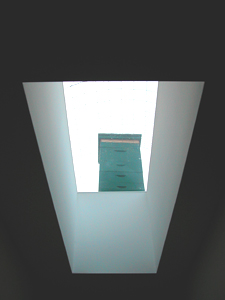 As you probably know by now, the bees don't fly much in the winter: they huddle together in a cluster inside the hive, and make warmth by flexing their little bee muscles. Mostly, beekeepers take one of two courses of (non)action during this season. The first is to philosophically accept that they have already done what they can for the bees, and that nature holds the rest of the cards. The second is to hover around, and wonder what superfluous actions (wrapping hives, providing extra food stores, sweeping nearby puddles off the roof...) might help the bees' chances.
As you probably know by now, the bees don't fly much in the winter: they huddle together in a cluster inside the hive, and make warmth by flexing their little bee muscles. Mostly, beekeepers take one of two courses of (non)action during this season. The first is to philosophically accept that they have already done what they can for the bees, and that nature holds the rest of the cards. The second is to hover around, and wonder what superfluous actions (wrapping hives, providing extra food stores, sweeping nearby puddles off the roof...) might help the bees' chances. You get only one guess concerning which camp issued my membership card.
The bees are almost always on my mind. Anytime you head upstairs, you can look at the Twain colony through the skylight above. And every time (sigh), I look for bees on the wing, or hope for a bit of sunshine on the side of the hives. Mostly in December there was nothing but a pale grey sky.
But things have, counterintuitively, brightened up in January. We are in an unseasonable warm spate (temps bumping up against 60 degrees F) and yesterday the activity outside the hive entrances seemed greater than in September! Even better, it seemed that the Wilde colony's Carniolans were running the bigger party!
The Carniolans have clearly been more active at lower temperatures throughout this season, and I am kind of wondering whether I should switch my chief anxiety from "Are there enough of them to survive?" to "Are they starting to raise brood too soon?" Therefore, after a spectacular failure at making bee candy (see link at right) on my own, I turned 10 pounds of sugar into about 3 gallons of 2:1 sugar syrup and hauled it up to the roof today. It is also supposed to be warm and rainy tomorrow, so I figured it would give the girls something to do while they were incarcerated.
As an afterthought, I grabbed a baggy of fake pollen (yes, you can buy fake pollen) and brought some of that up to the roof, too. If they are raising brood, they might like some protein. It also might be a bad idea, since giving them protein might cause them to start brood, but I am willing to take the chance.
When I popped the top on the Carniolans, they were already rocking and rolling inside. There were a couple of half hearted attempts by guard bees to demonstrate displeasure, but that all stopped when I poured the syrup. Many hundreds of bees stuck out their tongues and said "Yum!" I gave more than half of the syrup to the Wilde girls, because they had lower honey stores to start with. In checking a few days ago, they had 6 full frames in the top medium super still to go, and probably some more below, but I am not taking chances.
The Italian bees in Twain were their usual warmth-loving selves: not really into making an active response to me popping the lid. They got maybe a gallon, which those bees present took to right away. A few days ago, they had 8 full deep frames of honey above the cluster, so they are less likely to starve. I will be back in a few days to see how they are taking things, nonetheless.
For the first time, it really feels like they are going to make it. It might be a good idea not to get too excited about this, but it does my heart good: that and having bees buzzing around me again after such a long time.
1 comment:
I think it is wonderful that you are raising honey bees. Lord knows we need them. We are beekeepers and love our bees. We get about half the honey the make, this year 150 lbs and leave the other half for the bees. They are wonderful creatures. We keep the garden and flowers all organic. No chemicals. Our bees are doing great!
We live in Salt Lake City. Thanks, Ruth
Post a Comment